November 2007
Pilsner Urquell
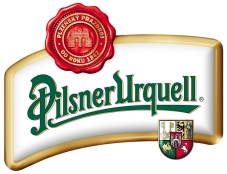
Hi all, as you know it has been a really long time since my last article. All of you must be foaming at the mouth for a brand new beer article, or should I say thirsting for a new report. Well it’s finally here and I hope it will help shed some light on the world’s most popular type of beer, Pilsner, the golden beer. My earliest memories of beer were of collecting beer bottle caps. On sunny weekends in the summer I would go with my family to Masaryk town in Scarborough, or Czech pool as we called it. There, my sister and I would go swimming, play outside or simply lie in the sun. For my parents it was a chance to go back home without leaving the country, meet friends and introduce their kids to Czech culture.
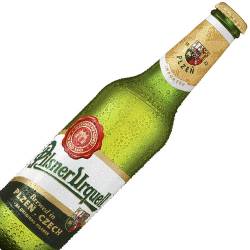 On the sprawling property there was a restaurant that served Czech food and of course Czech beer. This restaurant had a large outdoor patio that over looked beautiful rolling hills. On this terrace many a beer was consumed and the caps that preserved these popular beverages could be found on the ground below. As a boy I was drawn to the different logos and symbols found on these bottle caps. A very special bottle cap that became my favorite was wrapped in gold leaf, which had to be pealed away to get to the actual bottle cap. The cap had a picture of a barrel surrounding a gate, which was emblazoned with the capital letter P. I later learned that this bottle cap was from the beer Pilsner Urquell. I had great taste, even as a kid, for this bottle cap was from the world’s first golden lager.
On the sprawling property there was a restaurant that served Czech food and of course Czech beer. This restaurant had a large outdoor patio that over looked beautiful rolling hills. On this terrace many a beer was consumed and the caps that preserved these popular beverages could be found on the ground below. As a boy I was drawn to the different logos and symbols found on these bottle caps. A very special bottle cap that became my favorite was wrapped in gold leaf, which had to be pealed away to get to the actual bottle cap. The cap had a picture of a barrel surrounding a gate, which was emblazoned with the capital letter P. I later learned that this bottle cap was from the beer Pilsner Urquell. I had great taste, even as a kid, for this bottle cap was from the world’s first golden lager.
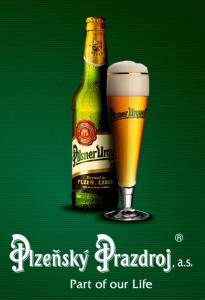 The Czechs have a long and proud brewing tradition. Even today they are the biggest beer drinkers in the world. They were among the first to use hops with their cultivation in Bohemia recorded as far back as 859 AD. Beer was a very important industry for the region, by the early 16th century some towns were generating close to 80% of their municipal income from beer production. By the end of the Middle Ages, export sales of both beer and prized Bohemian hops were booming. For the city of Plzen, beer began to be brewed since 1295. Brewing beer was a right given by the great Bohemian King Wenceslaus II and subsequently 250 citizens obtained this right. However much of the top-fermented beer being produced was of poor-quality. As a result better beer was imported from Bavaria and Saxony and cheaper beer was being brought in from the surrounding areas.
The Czechs have a long and proud brewing tradition. Even today they are the biggest beer drinkers in the world. They were among the first to use hops with their cultivation in Bohemia recorded as far back as 859 AD. Beer was a very important industry for the region, by the early 16th century some towns were generating close to 80% of their municipal income from beer production. By the end of the Middle Ages, export sales of both beer and prized Bohemian hops were booming. For the city of Plzen, beer began to be brewed since 1295. Brewing beer was a right given by the great Bohemian King Wenceslaus II and subsequently 250 citizens obtained this right. However much of the top-fermented beer being produced was of poor-quality. As a result better beer was imported from Bavaria and Saxony and cheaper beer was being brought in from the surrounding areas.
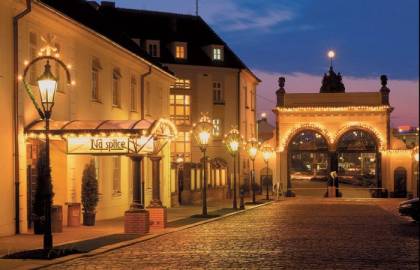
By the 1800’s the citizen’s of Plzen were not satisfied with these dark and cloudy, top fermented beers. The citizen’s protested the low quality and short storage life of the Topf Oberhefenbier, by dumping numerous barrels of the dark liquid into the streets. At the same time in Bavaria, brewers were experimenting with the storage of beer (in German the word for storage is lager) in cool caves using bottom-fermenting yeasts. This improved the beers clarity, flavour and shelf life. Most of this research was based on a German book written in Brno (a Czech city) in 1794 by Frantisek Ondrej Poupe. The Czech lands at the time were part of the Austro-Hungarian Empire.
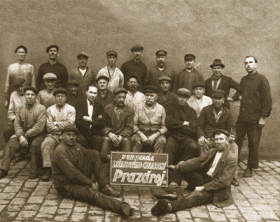
It was decided that a local brewery would be created to be capable of brewing bottom-fermented beer with a long storage life and consistent quality. The brewery was to fully realize the potential of experiments with lagering that were taking place in Bavaria. Plzen like Bavaria has the same climate and most importantly the ability to store ice in the winter to aid in fermentation, as tanks must be kept between 4-9 degrees Celsius all year round. The various citizen brewers joined together and became shareholders in a modern brewery, which was to produce sufficient amounts of good quality beer. In 1839 the Mestanky Pivovar, or the Citizens’ Brewery, was founded.
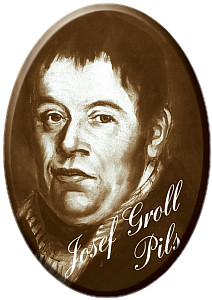 The Mestanky Pivovar then hired twenty-nine year old Bavarian brewmaster, Josef Groll to create a beer in the experimental Bavarian style of bottom fermentation. On October 5th, 1842 Groll produced the first batch of Pilsner Urquell beer using Bohemian soft water, a very pale malt and Saaz hops. The beer was first served to the public in the taverns Zum Goldenen Anker, Zur Weissen Rose and Hanes on Nov 11, 1842. The beer was very well received by the people. "What admiration there was when its golden colour shone forth and its snow-white foam rose above it, how the drinkers rejoiced at how this local product gloried in the full, remarkable taste, previously unknown for beer", recorded a chronicler. It’s golden colour was a novely at the time as glass drinking vessels were replacing stoneware steins and pewter tankards. It is no coincidence that Bohemian crystal became more and more popular and is now known throughout the world. The timing for the creation of the world’s first golden beer could not have been better.
The Mestanky Pivovar then hired twenty-nine year old Bavarian brewmaster, Josef Groll to create a beer in the experimental Bavarian style of bottom fermentation. On October 5th, 1842 Groll produced the first batch of Pilsner Urquell beer using Bohemian soft water, a very pale malt and Saaz hops. The beer was first served to the public in the taverns Zum Goldenen Anker, Zur Weissen Rose and Hanes on Nov 11, 1842. The beer was very well received by the people. "What admiration there was when its golden colour shone forth and its snow-white foam rose above it, how the drinkers rejoiced at how this local product gloried in the full, remarkable taste, previously unknown for beer", recorded a chronicler. It’s golden colour was a novely at the time as glass drinking vessels were replacing stoneware steins and pewter tankards. It is no coincidence that Bohemian crystal became more and more popular and is now known throughout the world. The timing for the creation of the world’s first golden beer could not have been better.
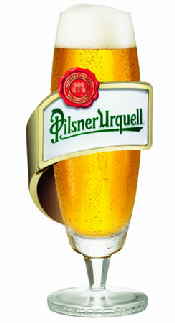 The remarkable taste of the world’s first golden beer is due to the quality of four raw materials; pale malt, saaz hops, soft water and yeast. The brewery assures the quality of the malt by producing it on site, to exact specifications. Two-row, fine husk Moravian barley is the main contributor to achieving the famous and distinctive golden hue. Pilsner Urquell uses only the finest hops in the world, Saaz hops. Saaz is the German name for the Czech region of Zatec, close to Plzen. Saaz hops create the flowery and spicy aroma characteristics. They are also a positive influence on the clarity of the beer, as well as creating a bitter tasting finish . The Saaz variety of hop has been called “the noble hop” and its cost reflects this. Another very important ingredient is the soft water that is drawn from the wells below the Plzen basin. The soft water ensures a pleasant bitter-sweet taste. The fourth ingredient, which is removed after fermentation, is yeast. Not just any yeast, this strain can trace its pedigree back to that used by Josef Groll. It is known as Pilsner H. Legend has it that a monk smuggled it out of a monastery and sold it to Josef to pay off a debt. The yeast produces a superior flavour and helps in the creation of the overall body of the beer.
The remarkable taste of the world’s first golden beer is due to the quality of four raw materials; pale malt, saaz hops, soft water and yeast. The brewery assures the quality of the malt by producing it on site, to exact specifications. Two-row, fine husk Moravian barley is the main contributor to achieving the famous and distinctive golden hue. Pilsner Urquell uses only the finest hops in the world, Saaz hops. Saaz is the German name for the Czech region of Zatec, close to Plzen. Saaz hops create the flowery and spicy aroma characteristics. They are also a positive influence on the clarity of the beer, as well as creating a bitter tasting finish . The Saaz variety of hop has been called “the noble hop” and its cost reflects this. Another very important ingredient is the soft water that is drawn from the wells below the Plzen basin. The soft water ensures a pleasant bitter-sweet taste. The fourth ingredient, which is removed after fermentation, is yeast. Not just any yeast, this strain can trace its pedigree back to that used by Josef Groll. It is known as Pilsner H. Legend has it that a monk smuggled it out of a monastery and sold it to Josef to pay off a debt. The yeast produces a superior flavour and helps in the creation of the overall body of the beer.
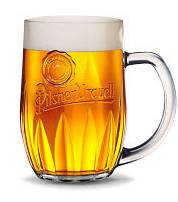 The brewing process is where all these quality ingredients come together. Pilsner Urquell uses a triple decoction process where the “mash” of Morvian malt grain and water goes through a heating process. Other breweries do this twice at most. This is crucial in maintaining Pilsner’s distinctive taste. Open flame heating, using a direct flame is a process also employed. Most other brewery’s employ electric or steam coiled heating devices. This step helps develop the golden colour, create a toasted bouquet and a balanced caramel flavour. The most important step is the fermentation process. This was one of the fundamental secrets that Josef Groll brought to Plzen. From 1660 Bavarian brewers stored brews in the alpine caves, where the coolness caused the yeast to drop to the bottom of the vats. As a result the beer was paler in colour.
The brewing process is where all these quality ingredients come together. Pilsner Urquell uses a triple decoction process where the “mash” of Morvian malt grain and water goes through a heating process. Other breweries do this twice at most. This is crucial in maintaining Pilsner’s distinctive taste. Open flame heating, using a direct flame is a process also employed. Most other brewery’s employ electric or steam coiled heating devices. This step helps develop the golden colour, create a toasted bouquet and a balanced caramel flavour. The most important step is the fermentation process. This was one of the fundamental secrets that Josef Groll brought to Plzen. From 1660 Bavarian brewers stored brews in the alpine caves, where the coolness caused the yeast to drop to the bottom of the vats. As a result the beer was paler in colour.
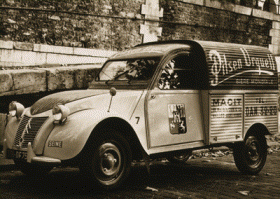
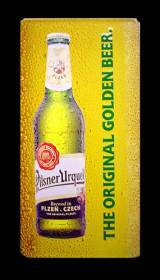 The new beer’s fame quickly spread and meant the end of imports into Plzen. The beer also won renown beyond Plzen and quickly lead to it‘s export. It soon reached the west Bohemian spa town of Karlovy Vary (Carlsbad in German), where the rich patients from the German states and France praised it‘s quality. It gradually began to gain the admiration of the world, including America in the 1870’s. In the mean time attempts to imitate the beer both within Plzen and abroad led to its trademarking in 1859 as Plzenske Pivo (Pilsner Beer). In 1898 the trademark names that are famous today, Pilsner Urquell (in German) and the Czech name, Plzensky Prazdroj came into existence. Pilsen, the english translation for the Czech city of Plzen, has given its name to what has become the world’s leading style of beer. It is a great compliment and tribute to the original Pilsner that beers around the world are called Pils, Pilsner or Pilsener. However none come close to the original, it’s creamy head, it’s strong hop flavour, it’s delicious full body, it’s golden colour and it’s refreshing bitterness. Don’t settle for any imitations. Purchase the Pilsner from the original source, the one with the read seal, imprinted with the original brewery gates that still stand to this day. Drink a piece of brewing history and Czech pride. Na Zdravi!
The new beer’s fame quickly spread and meant the end of imports into Plzen. The beer also won renown beyond Plzen and quickly lead to it‘s export. It soon reached the west Bohemian spa town of Karlovy Vary (Carlsbad in German), where the rich patients from the German states and France praised it‘s quality. It gradually began to gain the admiration of the world, including America in the 1870’s. In the mean time attempts to imitate the beer both within Plzen and abroad led to its trademarking in 1859 as Plzenske Pivo (Pilsner Beer). In 1898 the trademark names that are famous today, Pilsner Urquell (in German) and the Czech name, Plzensky Prazdroj came into existence. Pilsen, the english translation for the Czech city of Plzen, has given its name to what has become the world’s leading style of beer. It is a great compliment and tribute to the original Pilsner that beers around the world are called Pils, Pilsner or Pilsener. However none come close to the original, it’s creamy head, it’s strong hop flavour, it’s delicious full body, it’s golden colour and it’s refreshing bitterness. Don’t settle for any imitations. Purchase the Pilsner from the original source, the one with the read seal, imprinted with the original brewery gates that still stand to this day. Drink a piece of brewing history and Czech pride. Na Zdravi!
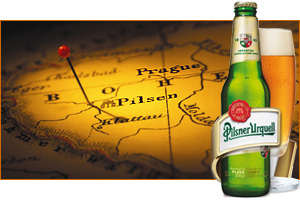
For more information on Pilsner Urquell go to:

Web sites of interest:
© 2006 (MR) roecken.ca

